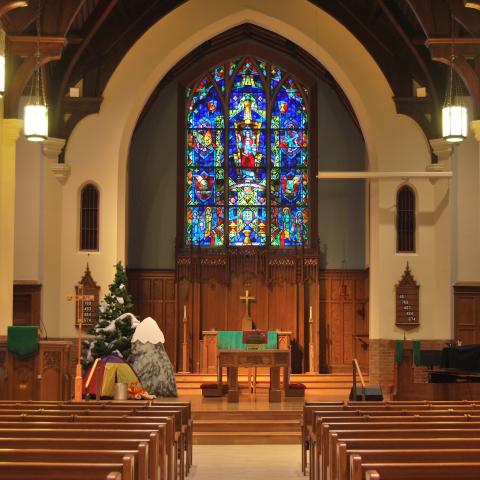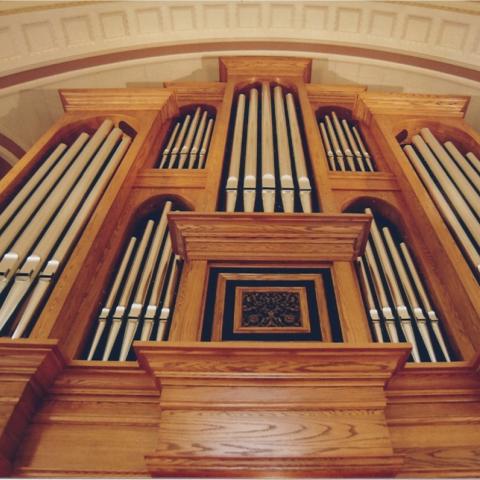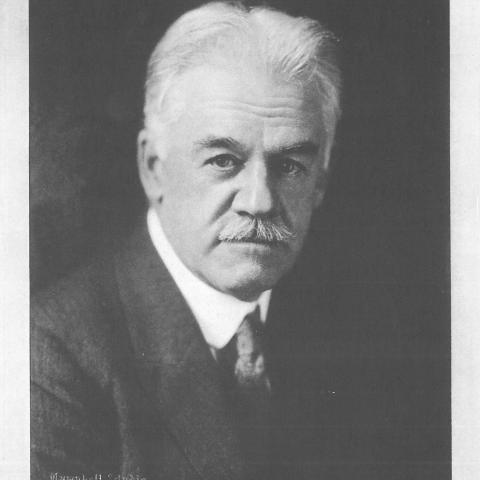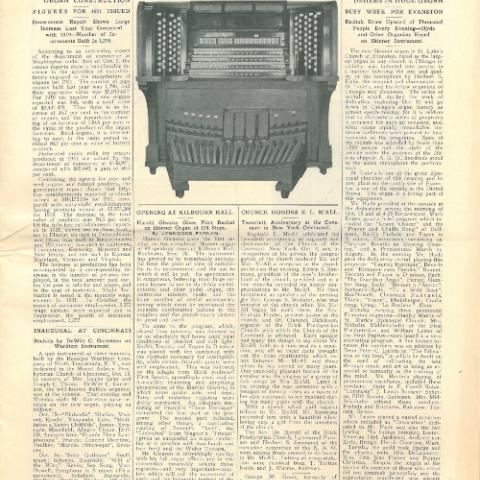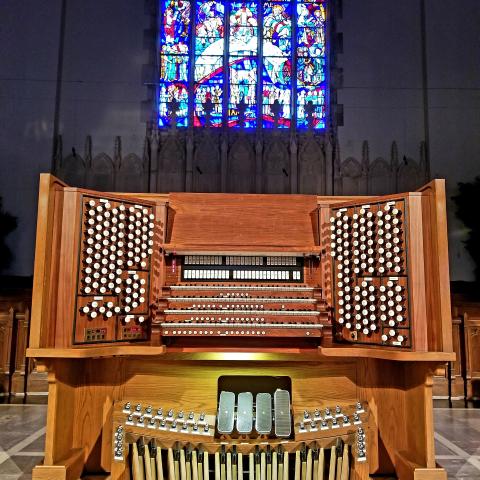Stephen Schnurr is editor and publisher of The Diapason; director of music for Saint Paul Catholic Church, Valparaiso, Indiana; and adjunct instructor in organ for Valparaiso University.

This article is a continuation of a series in the August 2015, June 2016, July 2017, February 2018, June 2018, and March 2021 issues of The Diapason. The information was delivered as a lecture for the Midwinter Pipe Organ Conclave on January 19, 2015, in La Grange, Illinois. The research for this project provides a history of a number of pipe organs in the village, but not all. For instance, organs in residences and theaters are not surveyed.
First Presbyterian Church was organized on May 13, 1890. The charter from the Presbytery of Chicago was accepted on October 27 of that year. The following year, property was purchased for construction of a church. The first church of local stone was dedicated on March 4, 1892. An estimated 500 persons crowded into the church seating 200. The building cost $5,336.
In 1907, the present property was purchased for $2,530. Construction for the first church at this location commenced in 1911, and the building was dedicated on March 3 of the following year. The design by architect Frank Jobson was patterned on a thirteenth-century church in Llambadarn, Wales, with a square tower and short spire. A picture of the model church was provided from the home of the church organist, J. Harry Jones.
The present church, built on the foundation of the earlier church, was dedicated on December 2, 1962, at a cost of $700,000. Charles Stade, well-known architect from Park Ridge, Illinois, drew the plans.
The first pipe organ for this congregation was built by W. W. Kimball of Chicago, an instrument of two manuals, seven ranks, and tubular-pneumatic action. The church is listed in both 1904 and 1913 catalogues of the builder. Further details on this organ are not available, but it was no doubt a standard Kimball “Portable” or “Boxcar” organ.
This instrument was taken in trade for Estey Opus 2798, a three-manual, 1929 rebuild of 1924 Estey Opus 2151, a two-manual instrument with player, originally placed in the Lyon & Healy studio of Chicago. In 1929, six ranks of pipes were added to the original thirteen, and a new three-manual “Master Keydesk” console provided. The organ was sold off the floor of the Chicago studio to the church, and the Kimball was resold to the Halleman Funeral Home, Chicago, for $1,150, less $400 for an Estey Style E two-manual reed organ.
The price for the organ to the La Grange church was $9,500, less $750 in trade for the Kimball. (Estey also proposed a brand new, three-manual organ, with five fewer ranks, for the same price.) Approval for purchase of the studio organ came from the church in April 1931. The instrument was placed in chambers at either side of the chancel, with a decorative, non-speaking pipe façade. The Estey was to be partially playable for a wedding on May 15 and finished by May 29. A commission of $250 was paid to Claude D. Pierce of La Grange.
1929 Estey Organ Company Opus 2798
GREAT (Manual II)
8′ Open Diapason (scale 43) 73 pipes
8′ Melodia 73 pipes
8′ Dulciana (scale 58) 73 pipes
4′ Octave (ext 8′ Open Diapason)
4′ Flute (ext 8′ Melodia)
2′ Fifteenth (fr 8′ Dulciana)
8′ Trumpet (by Gottfried) 73 pipes
Harp* 49 bars
SWELL (Manual III, Enclosed)
16′ Bourdon 97 pipes
8′ Open Diapason (Gt)
8′ Stopped Diapason (ext, 16′ Bourdon)
8′ Melodia (Gt)
8′ Viol Celeste (TC)* 49 pipes
8′ Salicional 73 pipes
8′ Dulciana (Gt)
8′ Aeoline* 61 pipes
4′ Flute (fr Gt 8′ Melodia)
4′ Flute d’Amour (ext 16′ Bourdon)
4′ Salicet (ext 8′ Salicional)
2-2⁄3′ Twelfth (fr Gt 8′ Dulciana)
2′ Piccolo (fr Gt 8′ Melodia)
III Dulciana Mixture (fr Gt 8′ Dulciana)
8′ Oboe* 61 pipes
8′ Vox Humana* 61 pipes
Tremolo
Chimes* 20 tubes
CHOIR (Manual I, Enclosed)
8′ Open Diapason (scale 41)* 61 pipes
8′ Clarabella* 61 pipes
8′ Unda Maris (TC)* 49 pipes
8′ Viol d’Orchestre* 61 pipes
8′ Viol d’Amour (scale 56)* 61 pipes
4′ Flauto Traverso* 61 pipes
8′ Saxophone* 61 pipes
8′ Clarinet* 61 pipes
Tremolo
PEDAL
16′ Open Diapason* 30 pipes
16′ Bourdon* 30 pipes
16′ Lieblich Gedeckt* 44 pipes
16′ Bass Viol 30 pipes
8′ Dolce Flute (ext 16′ Lieb)
* retained from Estey Opus 2151.
COUPLERS
Great to Pedal 8
Swell to Pedal 8
Swell to Pedal 4
Choir to Pedal 8
Great to Great 16
Gt. Uni. Sep.
Great to Great 4
Swell to Great 16
Swell to Great 8
Swell to Great 4
Choir to Great 16
Choir to Great 8
Choir to Great 4
Choir to Choir 16
Choir Uni. Sep.
Choir to Choir 4
Swell to Choir 16
Swell to Choir 8
Swell to Choir 4
Swell to Swell 16
Sw. Uni. Sep.
Swell to Swell 4
ACCESORIES
6 Universal pistons
6 Great and Pedal pistons
6 Swell pistons
6 Choir pistons
4 Pedal pistons
Great to Pedal reversible
Swell to Pedal reversible
Balanced Expression I
Balanced Expression II
Balanced Crescendo shoe (with indicator)
Sforzando reversible (with indicator)
Edwin Stanley Seder of the First Congregational Church of Oak Park played the dedicatory recital on Monday evening, June 1, 1931. Flora Hardie Burditt, contralto, assisted. There was a capacity crowd. The program:
Sinfonia to the Cantata “We Thank Thee, God,” J. S. Bach
Largo from Concerto in D Minor, J. S. Bach
O How Blessed Are Ye, Johannes Brahms
Pilgrim’s Chorus (Tannhauser), R. Wagner
Mr. Seder
I Will Sing New Songs of Gladness (Biblical Songs), A. Dvorak
The Mighty God Hath Spoken, Lincoln Case
Mrs. Burditt
Suite from Water Music, G. F. Handel
Allegro Vivace; Air; Hornpipe; Allegretto Giocoso; Allegro Maestoso
Mr. Seder
Offertory—Improvisation of a Well-known Hymn Tune
Prayer (Tristan and Isolde), R. Wagner
Mrs. Burditt
Canyon Walls (Mountain Sketches), Joseph W. Clokey
Dripping Spring (Sketches from Nature), Joseph W. Clokey
The Flight of the Bumble-Bee, N. Rimsky-Korsakoff
The Chapel of San Miguel (MS.), E. S. Seder
Carillon-Sortie, Henri Mulet
The church had several years to pay the debt for the organ in notes payable annually with interest. In 1932, a note of $2,000 with interest was due, and the church asked to pay $1,500 with interest, taking a new note for the remaining $500 due on December 1. The situation worsened in 1933 with our nation’s economy, and the congregation asked to pay $750–$1,000 towards its annual note of $2,000. Estey was also having troubles at that time, as the company was petitioned into receivership on February 20. The notes on the organ had been assigned to the First National Bank of Boston.
In October of 1936, the church complained of slow speech from the 1924 section of the organ, caused by rubberized cloth covering pneumatics that did not function properly and would cost approximately $500 to replace with leather. The church and the builder quarreled for a number of months over responsibility for repairs. Agreement for repair was finally reached on July 29, 1938. The church was closed for the month of August, and the work was to be completed by September 15.
In 1960, a contract was signed with the Aeolian-Skinner Organ Company of Boston, Massachusetts, for a three-manual, forty-rank gallery instrument (plus preparations for four additional stops), retaining some of the Estey organ in the chancel, which was installed in 1962, Opus 1390. The tonal director was Joseph Whiteford. The organ was designed by Thomas V. Potter, Aeolian-Skinner representative in Chicago, John J. Tyrell of Aeolian-Skinner, James A. Thomas, First Church minister of music, and James C. Andrews, also of the church.
The Estey organ was rebuilt under the direction of Andrews. Installation of the new organ was by Harold C. Lucas, representative for Aeolian-Skinner. Tonal finishing was by Lawrence L. Schoenstein of San Francisco, California. Correspondence on the organ, dated November 2, 1962, indicates that tonal finishing was delayed somewhat due to incompletion of the church, specifically, the installation of stained-glass windows. The organ was dedicated with the church on December 2, 1962, and named the Elsie Springer Hall Memorial Organ.
1962 Aeolian-Skinner Opus 1390
GREAT (Manual II, 3-1/4″ wind pressure)
16′ Quintatön (metal) 61 pipes
8′ Principal (metal) 61 pipes
8′ Bourdon (metal) 61 pipes
8′ Erzähler (prepared, blank knob)
4′ Octave (metal) 61 pipes
4′ Waldflöte (metal) 61 pipes
2′ Fifteenth (metal) 61 pipes
III–V Fourniture (C1–B1,III, C2–B2, IV, C3–C6, V, metal) 269 pipes
Chimes (in Swell, Deagan, five volume settings) 25 tubes
Swell to Great 16
Swell to Great 8
Swell to Great 4
Positiv to Great 16
Positiv to Great 8
Chancel to Great 8
Chancel to Great 4
SWELL (Manual III, Enclosed, 4″ wind pressure)
16′ Rohrbordun (metal) 80 pipes
8′ Viola (metal) 68 pipes
8′ Viola Celeste (metal) 68 pipes
8′ Rohrflöte (ext 16′)
8′ Flute Celeste II (metal, second rank TC) 124 pipes
4′ Spitz Principal (metal) 68 pipes
4′ Zauberflöte (prepared, blank knob)
2-2⁄3′ Nazard (metal) 61 pipes
2′ Blockflöte (metal) 61 pipes
IV Plein Jeu (metal) 244 pipes
16′ Fagotto (half-length, metal) 68 pipes
8′ Trompette (“#3 French,” metal) 68 pipes
4′ Rohrschalmei (“common,” metal) 68 pipes
Tremulant
Swell to Swell 16
Swell Unison Off
Swell to Swell 4
POSITIV (2″ wind pressure)
8′ Nasonflöte (wood) 61 pipes
8′ Flute Celeste (Sw)
4′ Koppelflöte (metal) 61 pipes
4′ Flute Celeste (Sw 8′)
2′ Prinzipal (metal) 61 pipes
1-3⁄5′ Terz (metal) 61 pipes
1-1⁄3′ Quinte (metal) 61 pipes
1′ Spillflöte (metal) 61 pipes
II Zimbel (metal) 122 pipes
8′ Krummhorn (prepared, blank knob)
Tremulant
Positiv to Positiv 16
Swell to Positiv 16
Swell to Positiv 8
Swell to Positiv 4
PEDAL (3-1/4″ wind pressure)
16′ Contra Basse (metal) 32 pipes
16′ Quintatön (Gt)
16′ Rohrbordun (Sw)
8′ Spitz Principal (metal) 44 pipes
8′ Quintatön (Gt 16′)
8′ Rohrflöte (Sw 16′)
4′ Choralbass (ext 8′ Spitz Principal)
4′ Rohrflöte (Sw 16′)
III Rauschquinte (metal) 96 pipes
16′ Bombarde (41⁄2″ scale, “French,” metal) 32 pipes
16′ Fagotto (Sw)
8′ Fagotto (Sw 16′)
4′ Fagotto (Sw 16′)
1 blank knob
Great to Pedal 8
Swell to Pedal 8
Swell to Pedal 4
Positiv to Pedal 8
CHANCEL
8′ Gedeckt (Estey 8′ Melodia)
8′ Gemshorn (Estey 8′ Dulciana, new pipes above tenor C)
8′ Gemshorn Celeste (prepared, TC)
4′ Montre (newer pipes)
2′ Principal (newer pipes)
III–IV Plein Jeu (prepared, to be 232 pipes)
8′ Festival Trumpet (newer pipes, “separate high pressure chest”)
1 blank knob
Chancel to Chancel 4
CHANCEL PEDAL
16′ Gedeckt (ext Chancel 8′ Gedeckt)
8′ Montre (ext Chancel 4′ Montre)
4′ Choralbass (fr Chancel 4′ Montre)
Chancel to Pedal 8
ACCESSORIES
6 General pistons (thumb and toe)
6 Great pistons (thumb)
6 Swell pistons (thumb)
6 Positiv pistons (thumb)
4 Chancel pistons (thumb)
6 Pedal pistons (toe)
General Cancel (thumb)
Setter button (thumb)
Pedal to Manual Comb. (Great, on/off, thumb)
Pedal to Manual Comb. (Swell, on/off, thumb)
Pedal to Manual Comb. (Positiv, on/off, thumb)
Great to Pedal reversible (thumb and toe)
Swell to Pedal reversible (thumb and toe)
Positiv to Pedal reversible (thumb)
Swell to Great reversible (thumb)
Swell to Positiv reversible (thumb)
Great Cancel (thumb, under Swell manual, and above Great stops)
Swell Cancel (thumb, under Swell manual, and above Swell stops)
Positiv Cancel (thumb, under Swell manual, and above Positiv stops)
Chancel Cancel (thumb, under Swell manual, and above Chancel stops)
Pedal Cancel (thumb, under Swell manual, and above Pedal stops)
Positiv/Chancel/Both/Release (buttons on right key cheek of Manual I)
Chancel on/off (buttons on right key cheek of Manual II)
Balanced Swell expression shoe
Balanced Chancel expression shoe
Balanced Crescendo shoe (with five green indicator lights)
Full Organ reversible (thumb and toe, with red indicator light)
Narthex signal button and light
Sacristy signal button and light
Choir Room signal button and light
Electric clock
The first recital was played by James A. Thomas, director of music, on January 13, 1963. The “official” dedicatory recital was played by Leonard Raver on March 17, 1963, playing a program of works by Buxtehude, Bruhns, Couperin, Stanley, Binkerd, Bingham, Alain, along with the Chicago-area premiere of Persichetti’s Sonata for Organ. The low-profile console stands three and three-quarters feet high, with all couplers located in the stop jambs. The instrument was featured on the cover page of the January 1963 issue of The Diapason.
Alec Wyton, Wilma Jensen, and Virgil Fox also concertized on this organ in its early years, performing to large audiences. The chancel organ has since been altered, was water-damaged in the late 1970s, fell silent, and has been removed.
The chancel also houses Brunzema Opus 3, a one-manual, four-rank mechanical-action portative organ, built in 1981. It represents the first of the firm’s Kistenorgel series. Brunzema pamphlets described the organ as follows:
The name of the Kisten Orgel comes from the Germanic word Kiste which literally means a wooden box or crate. The organ pipes are contained in a box and are protected when in use and also during transportation. This means that the instrument may not be too large or too heavy. Two persons should be able to carry the parts. It should not be necessary to hire a moving company for transportation. We have achieved this goal by building the organ in two parts: the upper section contains the windchest with the pipes, the lower section houses only the bellows and the electric blower. The critical dimension for ease of transportation is the depth of the larger part. Our instrument is only 48.5 cm (19-1/8 inches) and therefore fits through any door, and can even be moved around narrow corners and hallways.
Open metal pipes are cone-tuned, metal stopped pipes have soldered-on caps, for tuning stability. Key action is suspended mechanical. Pitch is A = 440 Hz. The organ has carved wood pipeshades on three sides for excellent tonal egress.
1981 Brunzema Opus 3
MANUAL
8′ Gedackt (oak and walnut, stopped) 50 pipes
4′ Flöte (oak and walnut, stopped) 50 pipes
2′ Prinzipal (12 basses stopped, 70% tin) 50 pipes
1-1⁄3′ Quinte (12 basses at 2⁄3′ pitch, 70% tin) 50 pipes

